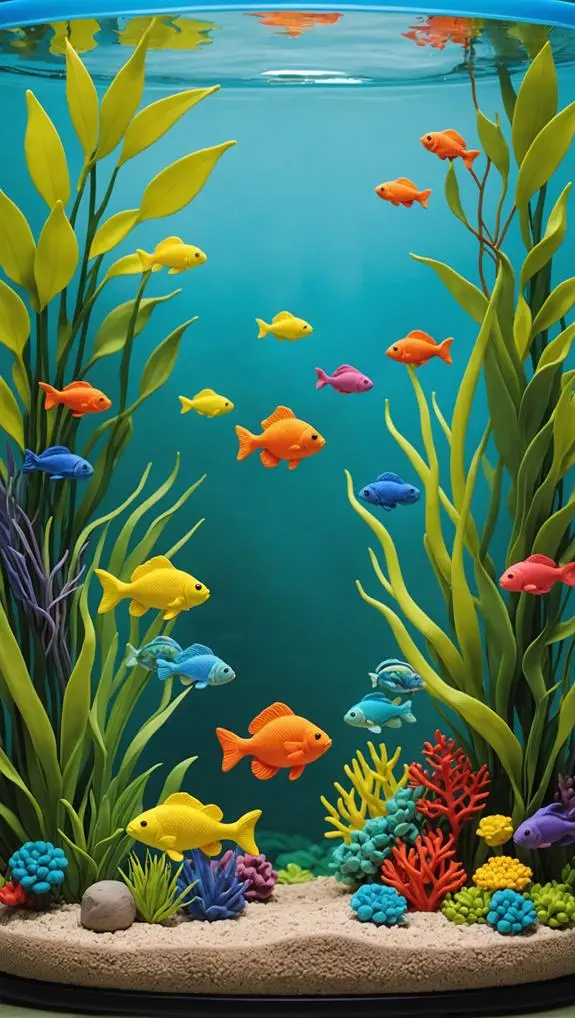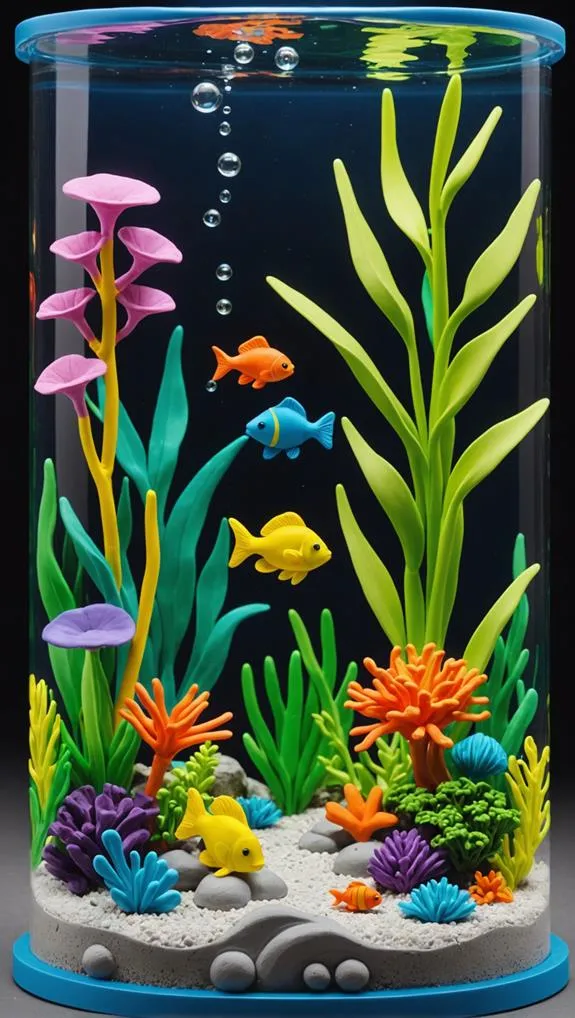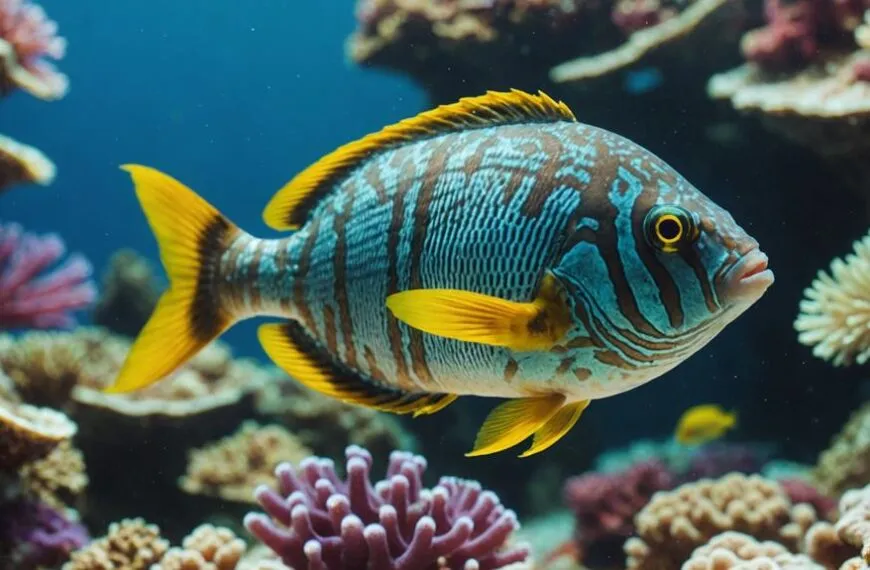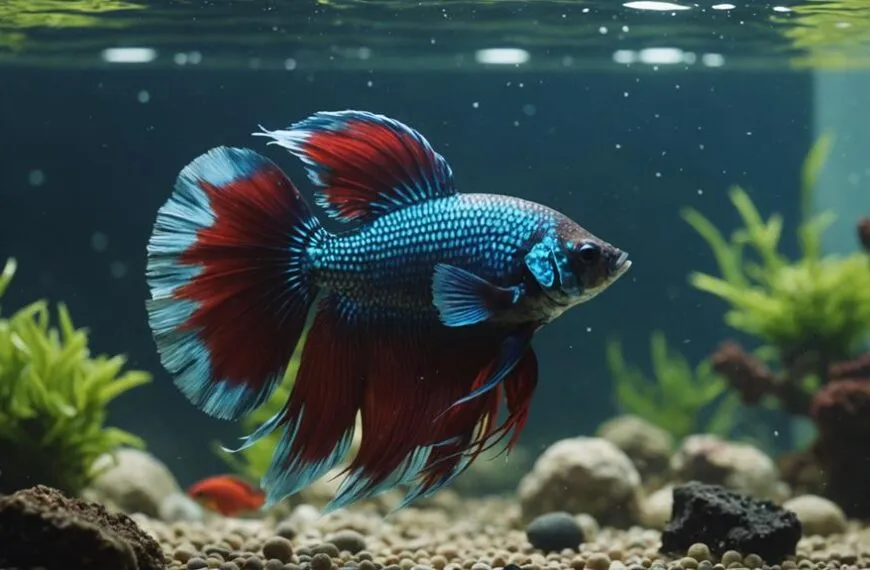To keep your fish happy and healthy, you've got to nail down water quality. Start by testing the pH—ideally between 6.5 and 7.8—for a stress-free zone. Remember, ammonia and nitrites should be at 0 ppm, or your fish might not be swimming with joy! A regular routine of 10-25% water changes will work wonders in reducing toxins. Don't forget the nitrogen cycle; give it time to kick in before introducing your fish pals. By keeping an eye on these factors, you'll create a vibrant home for your fins. Stick around to find out more tips for aquatic success!
Contents
Importance of Water Quality
Water quality is vital for the health of fish and supports diverse ecosystems. If you're passionate about caring for aquatic life, you know how crucial it's to keep your aquarium in top shape. Regular water quality checks prevent toxic buildup, such as ammonia and nitrites, ensuring a safe environment for your fish. The right pH levels, ideally between 6.5 and 7.8, can make all the difference.
If those levels dip too low or rise too high, your fish might feel stressed, and we definitely don't want that!
Ammonia levels are another biggie. You want them at 0 ppm because even tiny amounts can be toxic. Imagine your fish trying to swim in a toxic soup—that's just not fair to them! Regular water testing is your best friend here. It helps you keep an eye on hardness, nitrates, and phosphates, ensuring everything stays balanced for a healthy aquarium.
Monitoring these parameters is essential to prevent fish illnesses and promote optimal growth conditions for aquatic plants, consistent testing fosters balanced water quality.
When you prioritize water quality, you're not just keeping fish alive; you're supporting vibrant ecosystems. Healthy fish populations thrive in clean water, and your efforts contribute to that balance.
The Nitrogen Cycle Explained
Understanding the nitrogen cycle is key to keeping your fish happy and healthy. This essential process establishes beneficial nitrifying bacteria that convert toxic ammonia from fish waste into less harmful substances like nitrite and nitrate.
However, it doesn't happen overnight. By cycling your tank properly, you'll give those helpful bacteria time to work their magic, ensuring your fish aren't swimming in a toxic soup!
This process typically takes 4 to 8 weeks, influenced by tank size and temperature, making it crucial to monitor your water parameters closely to avoid issues related to new tank syndrome.
Ammonia to Nitrate Conversion
Starting with the waste produced by fish, the nitrogen cycle plays a crucial role in maintaining a healthy aquatic environment.
When fish do their thing, they produce ammonia, which is super toxic at any level above 0.0 ppm. That's where nitrifying bacteria come into play. These helpful little guys convert ammonia into nitrites, another toxic substance that you also want to keep at 0.0 ppm.
It's like a game of tag—one nasty player handing off the baton to the next!
As the cycle continues, nitrites are transformed into nitrates, thanks to another set of bacteria. Nitrates are less harmful, but if they exceed 50 ppm, they can stress out your fish.
Regular water testing is essential to ensure ammonia and nitrite levels stay at zero, while keeping nitrates in check for optimal fish health.
Completing the nitrogen cycle in a new tank can take weeks to months, depending on how well you manage your fish stocking and feeding practices.
Importance of Cycling Tank
Cycling your tank is essential for creating a stable environment for your fish. Think of it as preparing a cozy home before moving in your freshwater friends.
During cycling, beneficial nitrifying bacteria establish themselves, transforming toxic ammonia from fish waste into less harmful nitrites and then into nitrates. This process can take weeks to months, but it's worth the wait!
To keep those little buddies happy, you need to monitor ammonia levels closely. Even a hint of ammonia can stress them out, so aim for 0 ppm during this period.
It's best to start cycling with no fish, but once you've got a day under your belt, you can add a few hardy fish—just remember to limit new additions to three per week. This helps maintain stability in your aquarium.
Regular water testing is crucial during cycling. Checking ammonia, nitrite, and nitrate levels allows you to catch any issues before they become a problem.
Key Water Parameters

When you're setting up your aquarium, paying attention to key water parameters is super important for keeping your fish happy and healthy.
Maintaining a stable pH level, typically between 6.5 to 7.5, is crucial to prevent stress and health complications in your tropical fish pH stability matters.
You'll want to keep an eye on pH levels, manage ammonia and nitrite like a pro, and control those sneaky nitrates too.
Trust me, your fish will thank you for creating the perfect watery paradise!
Optimal Ph Levels
Maintaining the right pH levels in your aquarium is crucial for the health and well-being of your fish.
Most tropical freshwater fish thrive with a pH between 6.5 and 7.5, while African cichlids prefer their waters a bit more alkaline, at 7.8 to 8.5. If you're accommodating discus fish, they'll be happiest in more acidic conditions, ideally around 5.0 to 6.8.
It's like throwing a party; you want to set the mood just right!
Regular water changes are your best friend here, as they help stabilize pH levels that can drop over time due to organic waste.
It's like cleaning out the fridge — no one wants old food lurking around!
Monitoring your pH is vital for fish health, since sudden changes can stress your aquatic pals or, in the worst cases, lead to their demise.
Investing in a pH testing kit is essential. You can find these kits easily, and they'll help you keep tabs on your water's acidity.
Plus, pH alert sensors can give you notifications for timely adjustments.
With a little effort, you'll create a comfortable home for your fishy friends!
Ammonia and Nitrite Management
Ammonia and nitrite management is essential for creating a healthy aquarium environment. Keeping ammonia levels at 0.0 ppm is crucial, as even a small spike can harm your fish.
Similarly, nitrite levels should also be near zero since they can suffocate your aquatic friends. Regular testing is vital, especially during the nitrogen cycle when these levels can fluctuate wildly.
Here are some key steps to keep in mind:
- Use reliable testing equipment to monitor ammonia and nitrite levels.
- Perform regular water changes to dilute harmful substances.
- Introduce conditioner products to manage nitrite safely during cycling.
- Act quickly if ammonia or nitrite spikes occur—your fish depend on you!
- Educate yourself about the nitrogen cycle to understand what's happening in your tank.
Nitrate Control Strategies
Nitrate control is crucial for ensuring a thriving aquarium environment where your fish can flourish. Keeping nitrate levels below 40 ppm is essential to prevent stress and potential toxicity. One of the best ways to manage these levels is through regular water changes. Aim for 10-25% weekly or monthly; your fish will thank you for it!
Be mindful of uneaten food, as overfeeding can significantly raise nitrate levels. Limit feeding to what your fish can devour in one minute—think of it like a minute-long buffet! Incorporating live plants into your setup can also be a game-changer. They naturally absorb excess nitrates, improving water quality while giving your fish a beautiful environment to swim in.
Don't forget about your filtration systems! Investing in efficient filters and nitrate-absorbing media can help keep those pesky levels in check.
Regular Water Testing
To ensure a healthy environment for your fish, regular water testing is a must. By keeping an eye on your tank's water parameters, you'll help your fish thrive and prevent potential problems.
Think of it as checking in on your aquatic friends' well-being.
Here's what you should focus on during your regular water tests:
- pH Levels: Keep them between 6.5 and 8.2 for stability.
- Ammonia and Nitrite: Aim for 0.0 ppm; any higher can stress your fish.
- Nitrate Levels: Ideally, keep these below 40 ppm to avoid stress and algae growth.
- Chlorine and Chloramine: Use test kits to check for these harmful chemicals.
- General Hardness (GH): Maintain levels between 100-250 mg/L for optimal fish health.
Managing Ammonia Levels

Keeping ammonia levels in check is crucial for your fish's health and well-being. High ammonia can be toxic, even at tiny levels, so it's vital to strive for that perfect 0.0 ppm. You mightn't think about it, but fish waste, uneaten food, and decaying plants can all crank up those ammonia levels. Regular monitoring is key!
The nitrogen cycle plays a big role here, as it transforms ammonia into less harmful compounds. To make this process work, you'll want to cultivate beneficial nitrifying bacteria in your tank. These little helpers are essential for keeping ammonia levels low and your fish happy.
Don't forget about water changes! A weekly change of 10-25% helps dilute ammonia and other nasty stuff, creating a more stable environment for your aquatic friends.
Plus, consider investing in ammonia alert sensors. They provide real-time monitoring, so you can swoop in and save the day before any problems arise.
Your fish depend on you, and with a little effort, you can ensure they thrive in a healthy, safe home. Think of it as a team effort, where you're the superstar coach!
Controlling Nitrite and Nitrate
Controlling nitrite and nitrate levels is essential for maintaining a healthy aquarium environment. High nitrite levels can be toxic, suffocating your fish, while elevated nitrate levels can stress them and promote unwanted algae growth.
It's crucial to monitor these parameters, especially during the nitrogen cycle, which can take weeks to stabilize.
Here are some key practices to help you manage nitrite and nitrate effectively:
- Perform regular water changes to dilute harmful substances.
- Invest in an effective filtration system to keep the water clean.
- Avoid overfeeding your fish to prevent excess waste buildup.
- Introduce live plants that can help absorb nitrates naturally.
- Test your water regularly to keep track of these levels.
Ph Stability in Aquariums

Maintaining pH stability in your aquarium is vital for the health and well-being of your fish. Most freshwater tropical fish thrive best when pH levels are between 6.5 and 7.5, but some species, like African Cichlids, prefer a higher range of 7.8 to 8.5.
It's essential to keep an eye on those pH levels, as they can drop over time due to waste buildup and fish respiration. Regular monitoring is key to avoiding any surprises.
To help maintain stability, consider performing weekly water changes of about 10-25%. This not only dilutes the acidic buildup but also creates a healthier environment for your aquatic friends. Think of it as a refreshing spa day for your fish!
You might also want to invest in a pH alert sensor. This nifty device can catch sudden shifts in acidity, which is crucial in preventing stress or harm to your fish.
Best Practices for Water Changes
While regular water changes might seem like a chore, they're crucial for keeping your aquarium healthy and your fish thriving.
Think of it as a spa day for your underwater friends! By maintaining water quality through consistent changes, you can prevent harmful toxins from building up.
Here are some best practices to help you out:
- Perform weekly water changes, replacing about 10% of the water.
- Consider a 25% change once a month for a deeper clean.
- Vacuum the gravel monthly to remove waste and debris.
- Match the new water's temperature, pH, and hardness to your aquarium.
- Gradually replace water to avoid shocking your fish.
Frequently Asked Questions
How Do You Maintain Fish Water Quality?
To maintain fish water quality, you'll need regular water testing for pH balance, temperature control, and oxygen levels. Implement effective filtration systems and adjust parameters as necessary to create a thriving environment for your fish.
How Do I Make Sure My Fish Water Is Safe?
"An ounce of prevention's worth a pound of cure." To ensure your fish water's safe, focus on tank cycling, perform regular water changes, maintain your filter, ensure fish compatibility, and control algae effectively.
How Do I Improve My Aquarium Water Quality?
To improve your aquarium water quality, invest in effective filtration systems, regularly test water parameters, and maintain balanced oxygen levels. These steps aid algae control and create a thriving environment for your fish.
How Do I Keep My Aquarium Water Healthy?
Did you know that proper tank cycling can reduce fish stress by 60%? To keep your water healthy, focus on fish compatibility, regular water changes, effective filtration systems, and algae control for a thriving environment.
Final Thoughts
So, as you dive into ensuring your fish thrive, remember, water quality is key. Keep testing and managing those nitrogen levels, and don't forget about pH stability—it's like a spa day for your aquatic friends! With regular water changes and a little love, you're not just maintaining an aquarium; you're creating a vibrant underwater world. Just imagine their joyful little faces! Now, go on and make a splash—your fish will thank you for it!












